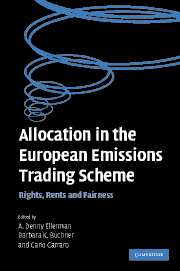Book contents
- Frontmatter
- Contents
- List of figures
- List of boxes
- List of tables
- List of contributors
- Introductory note/Foreword
- Acknowledgements
- Glossary and abbreviations
- Part I The EU ETS allocation process
- Part II Experiences from Member States in allocating allowances
- 3 United Kingdom
- 4 Germany
- 5 Denmark
- 6 Sweden
- 7 lreland
- 8 Spain
- 9 Italy
- 10 Hungary
- 11 Czech Republic
- 12 Poland
- Part III Concluding remarks and background material
- Appendix I Participants
- Appendix II The individual country outlines
- Appendix III The country tables
- Appendix IV Background material from the European Commission
- Index
10 - Hungary
Published online by Cambridge University Press: 22 September 2009
- Frontmatter
- Contents
- List of figures
- List of boxes
- List of tables
- List of contributors
- Introductory note/Foreword
- Acknowledgements
- Glossary and abbreviations
- Part I The EU ETS allocation process
- Part II Experiences from Member States in allocating allowances
- 3 United Kingdom
- 4 Germany
- 5 Denmark
- 6 Sweden
- 7 lreland
- 8 Spain
- 9 Italy
- 10 Hungary
- 11 Czech Republic
- 12 Poland
- Part III Concluding remarks and background material
- Appendix I Participants
- Appendix II The individual country outlines
- Appendix III The country tables
- Appendix IV Background material from the European Commission
- Index
Summary
Introductory background and context
As all the other continental new Member States of the EU, Hungary is a ‘country that is undergoing the process of transition to a market economy’ according to the United Nations Framework Convention on Climate Change (UNFCC), and shares most of their characteristics with respect to climate policy.
Hungary's trading sector CO2 emissions are relatively small compared to its size. The total quantity of allowances issued is about half of the trading sector emissions of Belgium, a country with an almost equal number of inhabitants. Though only half as populous as Hungary, Slovakia's trading sector emissions are almost equal to Hungary's. These relatively small emissions are attributable to the relatively small heavy industry, and an exceptionally high (40%) share of gas in the country's total primary energy supply. Significantly, unlike in most new Member States, electricity generation and distribution has been almost fully privatised, and is now owned mostly by the multinationals E.ON, RWE and EDF. The state still owns and operates the national electricity grid and the Paks nuclear power station.
Hungary, like all new Member States, has seen a steep decline in its plan-based carbon-intensive economies during the 1990s, and despite the subsequent rebound of economic activity, emissions are still well below their levels in the 1980s.
- Type
- Chapter
- Information
- Allocation in the European Emissions Trading SchemeRights, Rents and Fairness, pp. 246 - 268Publisher: Cambridge University PressPrint publication year: 2007
- 1
- Cited by



